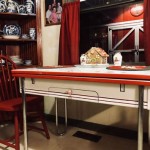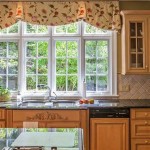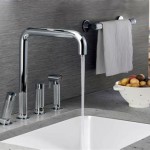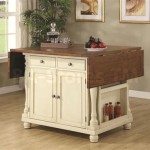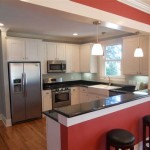Best Paint Colors for Kitchens: A Comprehensive Guide
Selecting the optimal paint color for a kitchen involves more than merely picking a preferred hue. It necessitates considering factors such as the kitchen's size, lighting conditions, architectural style, existing cabinetry and countertop materials, and the overall desired ambiance. The kitchen, often considered the heart of the home, is a space where functionality and aesthetics intersect. Therefore, the paint color chosen can significantly impact the room's perceived size, brightness, and overall appeal.
This guide explores various paint color options suitable for kitchens, detailing their characteristics and providing guidance on how to best incorporate them into different kitchen designs. The objective is to equip individuals with the knowledge needed to make informed decisions regarding kitchen paint colors, resulting in a space that is both visually pleasing and conducive to a productive and enjoyable cooking environment.
Understanding the Impact of Color Psychology in Kitchen Design
Color psychology plays a crucial role in how individuals perceive and interact with their environment. In the context of kitchen design, understanding these psychological effects can help create a space that promotes specific moods and behaviors. Certain colors are known to stimulate appetite, while others are associated with calmness and relaxation. Recognizing these connections is essential for crafting a kitchen environment that aligns with the homeowner’s desired atmosphere.
For instance, warm colors such as reds, oranges, and yellows are often associated with energy, excitement, and appetite stimulation. These colors can be invigorating and create a sense of warmth, making them suitable for kitchens where socializing and lively gatherings are common. However, these colors can also be overwhelming if used excessively, especially in smaller spaces. Cooler colors, such as blues, greens, and purples, are generally associated with calmness, tranquility, and relaxation. These are suitable for kitchens where a serene and calming atmosphere is desired. They can also create a sense of spaciousness, making them ideal for smaller kitchens.
Ultimately, the choice of color should be tailored to the specific needs and preferences of the homeowner, considering how the chosen color will impact their experience within the kitchen space. Thoughtful application of color psychology principles can transform a kitchen into a truly functional and aesthetically pleasing environment.
Popular Paint Color Options for Kitchens
Numerous paint colors are well-suited for kitchens, each offering a unique aesthetic and contributing to the overall ambiance of the space. The following provides a detailed overview of some of the most popular options:
White: White remains a timeless and versatile choice for kitchens. It offers a clean, bright, and airy feel, making it ideal for smaller kitchens or those with limited natural light. White reflects light effectively, creating a sense of spaciousness. Different shades of white can evoke different moods. For example, warm whites with creamy undertones create a cozy and inviting atmosphere, while cool whites with gray undertones offer a more modern and minimalist aesthetic. It is important to consider the existing materials in the kitchen, such as cabinets and countertops, when selecting the right shade of white to ensure a cohesive look. White also serves as a neutral backdrop that allows other design elements, such as colorful accessories or artwork, to stand out.
Gray: Gray has emerged as a sophisticated and contemporary alternative to white. It offers a wide range of shades, from light and airy to deep and dramatic, making it adaptable to various kitchen styles. Light grays, such as greige (a blend of gray and beige), can create a calming and sophisticated atmosphere, while darker grays can add depth and drama to the space. When considering gray, it is important to pay attention to the undertones. Some grays have cool, blue undertones, while others have warm, brown undertones. Choosing a gray with undertones that complement the existing cabinetry and countertops is crucial for achieving a harmonious look. Gray also pairs well with a variety of accent colors, such as blues, greens, and yellows, allowing for personalization and visual interest.
Blue: Blue is a versatile color that can create a range of different moods in the kitchen, from calming and serene to bold and vibrant. Light blues, such as sky blue or powder blue, can create a light and airy feel, while deeper blues, such as navy blue or indigo, can add a touch of sophistication and drama. Blue is often associated with cleanliness and freshness, making it a suitable choice for kitchens. It also pairs well with a variety of different materials, such as wood, stainless steel, and marble. When using blue in the kitchen, it is important to consider the lighting conditions. Darker blues can make a small kitchen feel even smaller and darker, while lighter blues can help to brighten up the space. Blue can also be used as an accent color to add pops of color and visual interest to a neutral kitchen.
Green: Green is a refreshing and natural color that can bring a sense of the outdoors into the kitchen. It is associated with tranquility, balance, and harmony, making it a suitable choice for creating a calming and inviting atmosphere. Light greens, such as sage green or mint green, can create a light and airy feel, while deeper greens, such as forest green or emerald green, can add a touch of sophistication and drama. Green pairs well with a variety of different materials, such as wood, stone, and metal. It also complements other natural colors, such as browns, beiges, and whites. When using green in the kitchen, it is important to consider the amount of natural light. Darker greens can make a small kitchen feel even smaller and darker, while lighter greens can help to brighten up the space. Green can also be used as an accent color to add pops of color and visual interest to a neutral kitchen.
Yellow: Yellow is an energetic and cheerful color that can brighten up any kitchen. It is associated with happiness, optimism, and creativity, making it a suitable choice for creating a welcoming and invigorating atmosphere. Light yellows, such as lemon yellow or pastel yellow, can create a light and airy feel, while deeper yellows, such as golden yellow or mustard yellow, can add a touch of warmth and richness. Yellow pairs well with a variety of different materials, such as wood, stainless steel, and white. It also complements other warm colors, such as oranges, reds, and browns. When using yellow in the kitchen, it is important to consider the intensity of the color. Too much yellow can be overwhelming, especially in a small space. It is often best to use yellow as an accent color or to choose a more muted shade of yellow.
Beige/Cream Beige and cream are neutral and versatile colors that provide a warm and inviting backdrop for any kitchen. They are less stark than white and can create a cozier atmosphere. These colors are particularly well-suited for kitchens with traditional or farmhouse styles. They pair well with natural wood tones, stone countertops, and rustic accents. Beige and cream also offer a timeless appeal, ensuring that the kitchen remains stylish for years to come. When selecting a beige or cream paint color, it is important to consider the undertones. Some beiges have warm, yellow undertones, while others have cooler, gray undertones. Choose a shade that complements the existing elements in the kitchen.
Factors to Consider When Choosing a Kitchen Paint Color
Selecting the right paint color for a kitchen involves a careful evaluation of various factors. Failing to consider these factors can result in a mismatched or unappealing kitchen aesthetic. The key factors include:
Kitchen Size and Layout: The size and layout of the kitchen significantly influence the choice of paint color. Smaller kitchens benefit from lighter colors, such as white, light gray, or pastel shades, as they reflect light and create a sense of spaciousness. Darker colors, while visually appealing, can make a small kitchen feel cramped and enclosed. In larger kitchens, a wider range of colors can be used, including darker shades and bolder hues. However, it is important to maintain a sense of balance and avoid overwhelming the space with too much color. The layout of the kitchen also plays a role. For example, an open-concept kitchen that flows into a living or dining area should have a paint color that complements the surrounding spaces. Similarly, kitchens with high ceilings can handle darker colors better than kitchens with low ceilings.
Lighting Conditions: The amount and type of lighting in the kitchen are crucial considerations. Natural light can significantly affect how a paint color appears. Colors can look different depending on the time of day and the direction of the sunlight. For example, a color that looks warm and inviting in the morning sunlight may appear cooler in the afternoon. Artificial lighting also plays a role. Incandescent lights tend to cast a warm glow, while fluorescent lights emit a cooler, more bluish light. It is important to test paint samples in the kitchen under different lighting conditions before making a final decision. Consider painting a large sample area on the wall and observing how the color looks throughout the day and under different types of lighting.
Existing Cabinetry and Countertops: The colors and materials of the existing cabinetry and countertops should be taken into account when selecting a paint color. The paint color should complement and enhance the overall look of the kitchen. For example, if the kitchen has warm wood cabinets, a cool-toned paint color, such as gray or blue, can provide a pleasing contrast. If the kitchen has white cabinets, a wider range of paint colors can be used, including bold and vibrant hues. Similarly, the color and pattern of the countertops should be considered. A busy countertop pattern may require a more neutral paint color to avoid visual clutter. Conversely, a plain countertop may benefit from a bolder paint color to add visual interest. It is helpful to bring paint samples to the kitchen and compare them to the existing cabinetry and countertops to ensure a harmonious match.
Desired Ambiance and Style: The desired ambiance and style of the kitchen are also important considerations. Do you want the kitchen to feel warm and inviting, or modern and minimalist? Do you prefer a traditional, farmhouse, or contemporary style? The paint color should reflect the desired atmosphere. For example, warm colors, such as yellow, orange, and red, can create a warm and inviting atmosphere, while cool colors, such as blue, green, and purple, can create a calming and serene atmosphere. Similarly, neutral colors, such as white, gray, and beige, can create a modern and minimalist look. The style of the kitchen should also be taken into account. A traditional kitchen may benefit from classic colors, such as white, cream, or sage green, while a contemporary kitchen may embrace bolder and more unconventional colors. Consider collecting inspiration images of kitchens that you admire and identifying the colors and styles that resonate with you.
By carefully considering these factors, individuals can make informed decisions regarding kitchen paint colors, resulting in a space that is both aesthetically pleasing and functional. The right paint color can transform a kitchen into a welcoming and enjoyable space for cooking, dining, and socializing.

70 Top Kitchen Paint Colors Best 2024

Get Creative With These Paint Colors For Your Small Kitchen Asian Paints

The Best Paint Colors For Your Kitchen Walls Block Guides

Dulux Kitchen Paint Colours

Here Are The Best Paint Colors For Every Kitchen Based On Sun Exposure

Paint For Kitchen Colour Walls Indigo Paints

8 Kitchen Wall Paint Colours For Your Home Designcafe

The Top 10 Most Popular Kitchen Colours Of 2024

Best Colors To Paint A Kitchen According The Experts

रस ई क द व र ड ज इन करन ल ए 13 सर वश ष ठ प ट ग च
Related Posts

